Indian Handlooms: Redefining modern luxury and global market potential

05 September 2024, Mumbai
Indian handloom industry, deeply rooted in the country's rich cultural heritage, is experiencing a remarkable resurgence. Designers, driven by a passion for sustainability and authenticity, are breathing new life into traditional weaving practices, redefining modern luxury and capturing the hearts of fashion enthusiasts worldwide.
As per estimates, Indian handloom market was valued at $1.35 billion in 2023 and is expected to grow at a CAGR of 10.21 per cent from 2023 to 2028, reaching $2.3 billion by 2028. This robust growth is a testament to the increasing global appreciation for handcrafted textiles and the growing demand for sustainable fashion choices.
Growth is getting a boost from increasing demand from both domestic and international markets, driven by factors like rising awareness about sustainable fashion. Handlooms, with their low carbon footprint and use of natural fibers, appeal to eco-conscious consumers. Growing appreciation for heritage and craftsmanship, with the unique artistry and cultural significance of handlooms resonating among those seeking authenticity and individuality. Government initiatives and schemes like the National Handloom Development Program are bolstering the sector.
Handlooms in mainstream apparel & retail
Handlooms are no longer confined to special occasions. Designers like Anavila Misra are infusing a contemporary aesthetic into handloom fashion, making it relevant for everyday wear. The use of modern silhouettes, color palettes, and styling is attracting younger consumers. Brands like Good Earth and Ogaan are making handlooms more accessible through their retail presence.
And designers like Vaishali Shadangule and Gaurav Khanijo are incorporating handlooms into their collections, showcasing their versatility and global appeal. They are experimenting with innovative designs and techniques, demonstrating that handlooms can be both traditional and trendsetting. Handlooms are also redefining luxury in India. Their handcrafted nature, unique textures, and cultural significance make them highly desirable for discerning consumers. Brands are positioning handlooms as symbols of exclusivity and conscious consumption.
Global market potential
The export potential of the Indian handloom business is vast. International markets, particularly those that value handcrafted and sustainable products, are increasingly drawn to the exquisite beauty and cultural richness of Indian handlooms. Gaurav Khanijo's collaborations with artisans across India and Shruti Sancheti's successful showcase at the BRICS+ Fashion Summit highlight the global demand for these textiles.
However, to fully realize the export potential, several challenges need to be addressed. Quality control and standardization is foremost. Ensuring consistent quality and adherence to international standards is a must. Creating a strong brand identity for Indian handlooms in global markets is also vital. And streamlining production and logistics to meet international demands is important for the handloom sector’s success internationally.
To sustain growth and reach its full potential, certain steps are crucial:
• Empowering weavers: Providing fair wages, skill development, and access to technology.
• Promoting ethical practices: Ensuring transparency and sustainability throughout the supply chain.
• Encouraging innovation: Blending tradition with contemporary design and technology.
• Creating a strong global brand: Highlighting the unique value proposition of Indian handlooms.
As designers, brands, and consumers continue to embrace handlooms, they are not only preserving a rich cultural heritage but also contributing to a more sustainable and ethical fashion industry. The Indian handloom industry is poised for bigger times as it weaves its way into the hearts and wardrobes of people across the globe.
Latest Publications

































